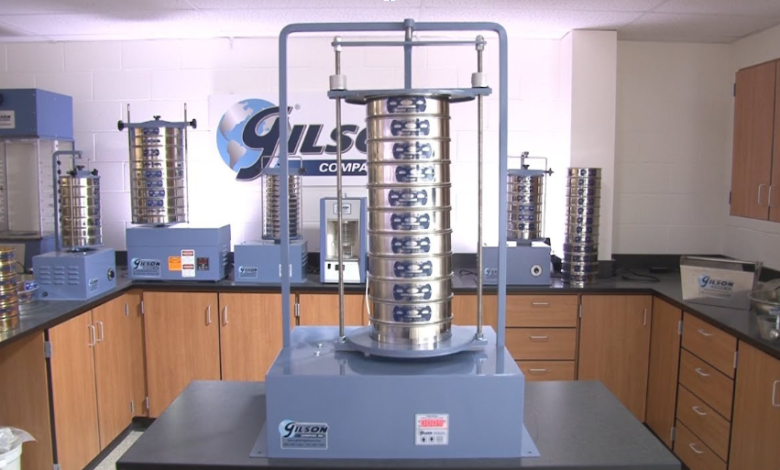How is Sieve Testing Equipment Used in Mining And Mineral Processing?

Introduction to Sieve Testing in Mining Operations
Sieve testing equipment represents one of the most fundamental and indispensable tools in the mining and mineral processing industry. This sophisticated yet conceptually straightforward technology serves as the backbone for particle size analysis, quality control, and process optimization across virtually every mining operation worldwide. The importance of accurate particle size determination cannot be overstated, as it directly influences extraction efficiency, product quality, environmental compliance, and overall operational profitability.
Mining operations today face unprecedented challenges in terms of ore complexity, environmental regulations, and economic pressures. In this demanding landscape, sieve testing equipment provides the critical data needed to make informed decisions about processing parameters, equipment selection, and product specifications. The technology has evolved significantly from simple mechanical screens to sophisticated automated systems capable of handling complex analysis requirements while maintaining the precision and reliability that mining operations demand.
The integration of sieve testing into mining workflows extends far beyond basic particle size measurement. Modern mining operations utilize these systems for process control, quality assurance, research and development, and regulatory compliance. The data generated by sieve testing equipment informs critical decisions about crushing and grinding circuits, flotation processes, dewatering operations, and final product specifications. This comprehensive approach to particle size analysis has become essential for maintaining competitive advantages in an increasingly challenging global marketplace.
Understanding the Fundamentals of Particle Size Analysis
Particle size distribution represents a critical parameter that influences virtually every aspect of mineral processing operations. The fundamental principle underlying sieve testing involves the separation of particles based on their geometric dimensions, typically using a series of standardized mesh screens with progressively smaller openings. This seemingly simple concept forms the foundation for complex analytical procedures that provide detailed insights into material characteristics and processing behavior.
The relationship between particle size and processing efficiency is multifaceted and highly dependent on the specific mineral being processed and the intended application. Fine particles often exhibit different chemical and physical properties compared to coarser materials, affecting everything from flotation kinetics to filtration rates. Understanding these relationships requires sophisticated analysis techniques that go beyond simple size measurement to include shape factors, surface area considerations, and particle distribution characteristics.
Modern sieve testing equipment incorporates advanced measurement principles that account for the three-dimensional nature of particles and their interaction with processing chemicals and equipment. The data generated provides insights into liberation characteristics, which determine how effectively valuable minerals can be separated from waste materials. This information is crucial for optimizing grinding circuits, where the goal is to achieve adequate liberation while minimizing over-grinding that can negatively impact downstream processes.
The statistical analysis of particle size distributions has become increasingly sophisticated, with mining operations utilizing advanced mathematical models to predict process performance based on feed characteristics. These models incorporate factors such as particle shape, surface roughness, and mineral composition to provide comprehensive assessments of material behavior throughout the processing circuit. The accuracy and reliability of these predictions depend heavily on the quality of particle size data generated by sieve testing equipment.
Types of Sieve Testing Equipment in Mining Applications
The diversity of sieve testing equipment available to mining operations reflects the wide range of materials, applications, and analytical requirements encountered in mineral processing. Traditional mechanical sieving systems remain popular for routine analysis applications, offering reliable performance and straightforward operation for standard particle size determinations. These systems typically utilize electromagnetic or mechanical vibration to promote particle movement through the sieve stack, with analysis times ranging from several minutes to over an hour depending on the material characteristics and required precision.
Automated sieve testing systems have gained widespread acceptance in mining laboratories due to their ability to improve consistency, reduce operator variability, and increase throughput. These sophisticated instruments incorporate programmable vibration patterns, automatic timing controls, and integrated data management systems that eliminate many sources of human error while providing detailed documentation of testing procedures. The automation capabilities extend to sample handling, where robotic systems can manage multiple samples simultaneously, significantly increasing laboratory productivity.
Air jet sieving represents a specialized application particularly valuable for fine particle analysis and materials that tend to agglomerate or blind traditional screens. This technology utilizes controlled air pulses to disperse particles and promote separation, making it ideal for analyzing clay minerals, fine tailings, and other challenging materials commonly encountered in mining operations. The gentle action of air jet sieving preserves particle integrity while achieving separation efficiency that would be difficult to obtain with mechanical vibration alone.
Ultrasonic sieving systems address the challenges associated with very fine particles and materials with high moisture content. The ultrasonic energy helps prevent screen blinding while promoting efficient separation of particles that might otherwise be retained on screens due to electrostatic forces or surface tension effects. This technology has proven particularly valuable for analyzing mineral concentrates, where accurate fine particle measurement is critical for process optimization and quality control.
The Critical Role of Sieve Analysis in Mineral Processing
Mineral processing operations rely heavily on particle size control to achieve optimal separation efficiency and product quality. The relationship between particle size and liberation is fundamental to understanding how effectively valuable minerals can be separated from gangue materials. Sieve testing equipment provides the detailed particle size information needed to optimize grinding circuits, where the primary objective is to achieve adequate mineral liberation while minimizing energy consumption and over-grinding.
Flotation processes, which represent the primary separation method for many mineral commodities, are particularly sensitive to particle size distribution. Fine particles often exhibit different flotation kinetics compared to intermediate-sized particles, while very coarse particles may not float effectively due to their weight relative to the buoyancy forces generated by attached air bubbles. Sieve analysis data enables process engineers to optimize grinding circuits to produce particle size distributions that maximize flotation recovery while maintaining acceptable concentrate grades.
Dewatering and filtration operations, which are essential for producing marketable mineral concentrates, are also significantly influenced by particle size characteristics. Fine particles can create filtration challenges by forming low-permeability filter cakes, while coarse particles may allow excessive water retention. Sieve testing data helps optimize these processes by providing insights into particle packing characteristics and their impact on liquid-solid separation efficiency.
The quality control aspects of mineral processing rely extensively on sieve analysis for monitoring product specifications and ensuring compliance with customer requirements. Many mineral products have strict particle size specifications that must be met to maintain market acceptance and pricing. Continuous monitoring through sieve testing enables rapid identification of process deviations and implementation of corrective actions before significant quantities of off-specification material are produced.
Operational Procedures and Best Practices
Effective utilization of sieve testing equipment in mining operations requires adherence to standardized procedures and best practices that ensure data quality and reproducibility. Sample preparation represents a critical first step, as the representativeness and condition of the test sample directly influence the validity of results. Proper sampling techniques must account for material heterogeneity, moisture content, and particle segregation effects that can bias analytical results.
The selection of appropriate sieve sizes and testing parameters requires careful consideration of the material characteristics and intended application of the results. Standard sieve series provide a systematic approach to particle size analysis, but specific applications may require customized sieve combinations to capture critical size fractions or achieve required resolution in particular size ranges. The testing duration, vibration intensity, and sample mass must be optimized for each material type to ensure complete separation while avoiding particle degradation.
Calibration and maintenance procedures for sieve testing equipment are essential for maintaining data quality and equipment reliability. Regular verification of sieve mesh openings, vibration characteristics, and timing systems helps identify potential sources of error before they impact analytical results. Documentation of maintenance activities and performance verification provides traceability and supports quality assurance programs that are increasingly important for regulatory compliance and customer acceptance.
Data management and interpretation procedures have become increasingly sophisticated as mining operations seek to extract maximum value from analytical information. Modern sieve testing systems generate large quantities of data that require systematic analysis to identify trends, detect process deviations, and support optimization efforts. Statistical process control techniques help distinguish between normal process variation and significant changes that require investigation or corrective action.
Quality Control and Standardization in Mining Operations
Quality control programs in mining operations rely heavily on standardized sieve testing procedures to ensure consistency and accuracy of particle size determinations. International standards such as ASTM, ISO, and national standards provide detailed protocols for sieve analysis that address everything from sample preparation to data reporting. Adherence to these standards is essential for achieving reproducible results and maintaining credibility with customers, regulators, and certification bodies.
Proficiency testing programs play a crucial role in validating the accuracy and precision of sieve testing operations. These programs involve analysis of reference materials with known particle size distributions, allowing laboratories to assess their performance against established benchmarks. Regular participation in proficiency testing helps identify systematic errors, training needs, and equipment issues that might otherwise go undetected.
Measurement uncertainty assessment has become an increasingly important aspect of quality control in mining laboratories. Understanding and quantifying the various sources of uncertainty in sieve analysis helps establish appropriate confidence levels for decision-making and ensures that analytical results are interpreted correctly. Factors contributing to measurement uncertainty include sampling effects, equipment limitations, operator variability, and environmental conditions.
Documentation and traceability requirements continue to expand as mining operations face increased scrutiny from regulatory agencies and stakeholders. Comprehensive records of sieve testing procedures, equipment calibration, operator training, and quality control activities provide evidence of due diligence and support legal and commercial requirements. Electronic data management systems facilitate this documentation while improving data accessibility and analysis capabilities.
See also: How Biotechnology and AI Are Merging
Advanced Sieve Testing Technologies and Automation
The evolution of sieve testing technology has been driven by demands for improved accuracy, increased throughput, and reduced operator involvement. Modern automated systems incorporate sophisticated control algorithms that optimize testing parameters based on material characteristics and analysis objectives. These systems can adjust vibration patterns, testing duration, and other parameters in real-time to achieve optimal separation efficiency while minimizing analysis time.
Digital imaging and analysis capabilities represent a significant advancement in sieve testing technology, providing detailed information about particle shape, surface texture, and other morphological characteristics that influence processing behavior. These systems can analyze thousands of particles in seconds, generating statistical data that would be impossible to obtain through manual methods. The combination of size and shape analysis provides a more complete understanding of material characteristics and their impact on processing performance.
Integration with process control systems enables real-time monitoring and adjustment of mineral processing operations based on sieve analysis results. Automated sampling systems can collect representative samples from process streams at predetermined intervals, with results fed directly into control algorithms that adjust equipment settings to maintain optimal performance. This closed-loop approach to process control represents a significant advancement in mining technology.
Wireless connectivity and remote monitoring capabilities allow mining operations to access sieve testing results from anywhere in the world, supporting centralized technical expertise and rapid response to process deviations. Cloud-based data storage and analysis platforms provide powerful tools for trend analysis, predictive modeling, and optimization studies that would be impractical with traditional data management approaches.
Economic Impact and Cost Optimization Through Sieve Testing
The economic benefits of effective sieve testing programs in mining operations extend far beyond the direct costs of analytical services. Optimization of grinding circuits based on particle size analysis can result in significant energy savings, as grinding typically represents one of the largest energy consumers in mineral processing operations. Even small improvements in grinding efficiency can translate to substantial cost reductions over the life of a mining operation.
Product quality improvements achieved through better particle size control can command premium pricing and reduce customer complaints or product returns. Many mineral products have strict specifications for particle size distribution, and consistent achievement of these specifications can differentiate a producer in competitive markets. The ability to demonstrate consistent quality through comprehensive sieve testing documentation also supports long-term customer relationships and contract negotiations.
Process efficiency improvements resulting from optimized particle size distributions can increase plant throughput, improve recovery rates, and reduce operating costs. Better understanding of the relationship between feed characteristics and process performance enables operators to maximize the value extracted from each ton of ore processed. This optimization becomes increasingly important as ore grades decline and processing costs increase.
Risk management benefits of comprehensive sieve testing programs include early detection of equipment problems, identification of ore characteristic changes, and verification of process modifications before full-scale implementation. The cost of analytical testing is typically insignificant compared to the potential costs of undetected process problems or suboptimal operating conditions.
Environmental Considerations and Sustainability
Environmental compliance in mining operations increasingly relies on accurate characterization of particulate materials, including waste streams, emissions, and rehabilitation materials. Sieve testing equipment plays a crucial role in demonstrating compliance with regulatory requirements for dust control, tailings management, and site rehabilitation. Detailed particle size analysis supports environmental impact assessments and helps optimize control measures to minimize environmental effects.
Waste minimization efforts in mining operations benefit significantly from detailed understanding of particle size distributions in various process streams. Sieve analysis can identify opportunities to recover valuable materials from waste streams or optimize dewatering processes to reduce the volume of materials requiring disposal. These applications contribute to both environmental sustainability and economic performance.
Water management in mining operations is increasingly critical due to water scarcity and environmental regulations. Particle size analysis supports optimization of water treatment processes, including clarification, filtration, and recycling systems. Understanding the relationship between particle characteristics and water treatment efficiency enables mining operations to minimize water consumption while maintaining environmental compliance.
Rehabilitation and closure planning for mining operations requires detailed characterization of various materials that will remain on site after mining ceases. Sieve analysis supports assessment of erosion potential, vegetation establishment requirements, and long-term stability of rehabilitated areas. This information is essential for developing effective closure plans that minimize long-term environmental liabilities.
Future Trends and Technological Developments
The future of sieve testing in mining operations is being shaped by advances in automation, artificial intelligence, and sensor technology. Machine learning algorithms are being developed to optimize testing procedures based on material characteristics and analysis objectives, potentially reducing analysis time while improving accuracy. These systems can learn from historical data to predict optimal testing parameters for new materials or changed conditions.
Portable and field-deployable sieve testing equipment is becoming increasingly sophisticated, enabling on-site analysis that can support real-time decision-making. These systems must balance analytical capability with ruggedness and ease of operation, as they may be used by personnel with limited laboratory training. Advances in miniaturization and battery technology are making these systems increasingly practical for field applications.
Integration with other analytical techniques is expanding the information content available from particle characterization studies. Combined sieve analysis and surface area measurement, for example, can provide insights into particle shape and surface roughness that influence flotation behavior. Multi-technique analysis platforms are becoming more common as mining operations seek comprehensive material characterization from single samples.
Predictive maintenance capabilities for sieve testing equipment are being enhanced through integration of sensors and data analytics. These systems can monitor equipment performance parameters and predict when maintenance will be required, reducing unplanned downtime and ensuring consistent analytical performance. Integration with enterprise asset management systems provides comprehensive visibility into equipment condition and maintenance requirements.
Certified Material Testing Products (Certified MTP) is a leading supplier of construction materials testing equipment and laboratory supplies in the United States. They offer a comprehensive range of products for testing concrete, asphalt, aggregate, soil, and cement, catering to both field and laboratory applications But no matter whether they are prefered or not, the whole idea behind these tools is similar: getting a polished, shiny, and permanent effect. New to stucco or a seasoned pro, investing in good tools and learning the nuances of their use is what will get you started perfecting your craft.
Frequently Asked Questions (FAQ)
What is the primary purpose of sieve testing in mining operations?
Sieve testing in mining operations serves multiple critical purposes, with particle size analysis being the primary function. This analysis is essential for optimizing mineral processing circuits, controlling product quality, ensuring regulatory compliance, and maximizing economic recovery. The data generated helps engineers understand how materials will behave in various processing steps and enables optimization of operating parameters to achieve desired outcomes.
How often should sieve testing be performed in a typical mining operation?
The frequency of sieve testing depends on various factors including ore variability, process stability, and quality requirements. Typical mining operations may perform routine sieve analysis several times per shift for critical process streams, with additional testing conducted when process conditions change or problems are suspected. Quality control programs often specify minimum testing frequencies based on production rates and material characteristics.
What are the most common challenges encountered when performing sieve analysis on mining materials?
Common challenges include handling materials with high moisture content, dealing with clay minerals that tend to blind screens, analyzing very fine particles that may not separate effectively, and managing samples with wide size distributions. Additionally, some materials may be prone to degradation during testing, and representative sampling can be difficult for heterogeneous ores. Proper sample preparation and selection of appropriate testing techniques are essential for addressing these challenges. For more Any Business Card, check out this guide from NFC Business Card Temperature corrections for measuring equipment become particularly important during extreme weather conditions.
How do environmental conditions affect sieve testing results?
Environmental conditions such as temperature, humidity, and air currents can significantly impact sieve testing results. High humidity can cause fine particles to agglomerate or adhere to screens, while temperature variations can affect material properties and screen characteristics. Controlled laboratory conditions are typically required for accurate and reproducible results, with specific requirements varying depending on the material being tested and the precision required.
What training is required for personnel operating sieve testing equipment?
Personnel operating sieve testing equipment require training in sampling techniques, equipment operation, safety procedures, data interpretation, and quality control practices. The level of training depends on the complexity of the equipment and the criticality of the results. Many mining operations require formal certification or demonstrated competency before allowing personnel to perform unsupervised testing. Ongoing training is important to maintain skills and keep current with evolving procedures and technologies.
How do modern automated sieve testing systems compare to traditional manual methods?
Modern automated systems offer significant advantages in terms of consistency, throughput, and data management compared to traditional manual methods. Automation reduces operator variability, enables standardized procedures, and provides comprehensive documentation of testing parameters. However, automated systems require higher initial investment and more sophisticated maintenance procedures. The choice between automated and manual systems depends on testing volume, precision requirements, and available resources.
What role does sieve testing play in process optimization and troubleshooting?
Sieve testing provides critical diagnostic information for process optimization and troubleshooting. Changes in particle size distribution can indicate equipment wear, process upsets, or changes in feed characteristics. Systematic analysis of size distribution data helps identify the root causes of processing problems and evaluate the effectiveness of corrective actions. This information is essential for maintaining optimal plant performance and minimizing operating costs.
How do regulatory requirements impact sieve testing procedures in mining?
Regulatory requirements increasingly influence sieve testing procedures in mining operations, particularly regarding environmental compliance, worker safety, and product quality. Many jurisdictions require specific analytical procedures and documentation for environmental monitoring and waste characterization. International trade requirements may specify particular testing standards for exported mineral products. Compliance with these requirements is essential for maintaining operating licenses and market access.
What considerations are important when selecting sieve testing equipment for a mining operation?
Key considerations include the range of materials to be tested, required analytical precision, testing throughput requirements, operator skill levels, maintenance capabilities, and integration with existing laboratory systems. The harsh operating environment typical of mining operations requires equipment designed for reliability and ease of maintenance. Cost considerations must balance initial equipment investment against ongoing operating costs and the value of analytical information generated.
How is sieve testing data integrated into modern mining operations management systems?
Modern mining operations increasingly integrate sieve testing data into comprehensive management systems that support real-time decision-making and long-term optimization studies. Laboratory information management systems capture and store analytical results, while process control systems use this data to adjust equipment settings automatically. Enterprise resource planning systems may incorporate analytical results into production planning and quality management processes. This integration enables mining operations to maximize the value of analytical information while ensuring data integrity and traceability.




